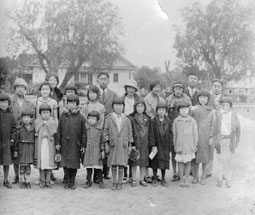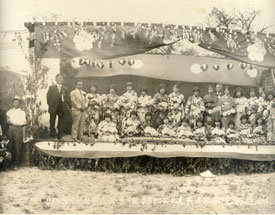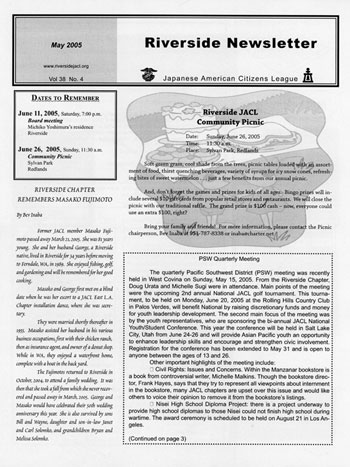Japanese Americans in Riverside
It is not clear when the first Japanese came to Riverside , but by the mid-1890s, sizable numbers of Japanese men worked in the citrus groves that were the backbone of the city's economy. By 1900, as many as three thousand Japanese laborers lived in Riverside during the citrus harvest, though their numbers waxed and waned with the agricultural cycle. They worked in the groves alongside Whites, Chinese, Koreans, and Mexicans.
Not all the Japanese were agricultural workers, though. In 1890, the first Japanese-owned grocery store in Riverside was opened by the Kumaru brothers, and in 1895, the first Japanese-owned restaurant was started by Isokichi Ezawa (serving 'American' food). Two more Japanese grocery stores were opened in 1900 and 1901 and they quickly began to serve as contractors for Japanese laborers, serving as middlemen between the Japanese workers and the citrus plantation managers (Morrison Wong 1977: 19). In 1902, Yagichiro Kinoshita started up a large-scale chicken and hog ranch in west Riverside . By 1908, a Japanese Association (Nihonjin-kai) had been established and had about four hundred members-presumably all or most of the adult Japanese men in Riverside (op. cit. 20).
Most of the Japanese in Riverside at that point were originally from either of two prefectures (administrative districts) in Japan, Wakayama-ken or Fukuoka-ken, and two additional associations based on prefectural origin were formed in Riverside-the Wakayama kenjin-kai and the Fukuoka kenjin-kai. These institutions served a social function (sponsoring get-togethers like picnics), whereas the Japanese Association also created a bridge to local non-Japanese business concerns (Wong 1977: 22). By 1910, Riverside had about five hundred year-round Japanese residents, including seventy women and twenty-five children. Japanese-owned businesses included two grocery stores, four pool halls, two barbershops, two rooming houses, one hotel, two bicycle shops, three restaurants, one tobacco shop, one confectionary, two labor contractors,, three employment agencies, one fish market, and one tailor (op. cit. 23). There was a small concentration of Japanese businesses in downtown Riverside near University Avenue and Main Street and another on Fourteenth Street near the railroad tracks.
During this same period, anti-Japanese hostility sometimes flared up when White laborers feared economic competition. In 1896, for instance, a group of White laborers attacked some thirty Japanese laborers and drove them out of town. Similar incidents took place in the nearby cities of Redlands, Rialto, Highland, Upland, Cucamonga, and Corona between 1895 and 1905 (op. cit. 36).
During this same decade, a remarkable Japanese businessman named Ulysses Shinsei Kaneko put down roots in Riverside. In 1896, he became a naturalized American citizen-the first Japanese in the Inland Empire of Southern California to do so. He was the first Japanese to buy land in Riverside -twenty acres for $60 per acre in April 1897; he planted orange trees. In 1899 he helped to purchase the land for the Japanese Methodist Church, which was built between 1901-02, and he served as its co-founder. He was the first president of the Riverside Japanese Association, worked as an auditor for the City of Riverside, served as a translator in the courts, served on a Grand Jury, and by 1910 had been elected to the Riverside Chamber of Commerce Board of Directors. His restaurant on University Avenue catered mainly to White customers (including city officials, for whom he maintained a private back room), and-no doubt with the help of his highly-placed White associates-operated a labor camp that supplied Japanese workers to the railroads and to the citrus plantations. If Kaneko was a bit anomalous (the vast majority of the Japanese in Riverside were laborers), he certainly managed to go far. Sociologist Morrison Wong has speculated that Kaneko and in fact much of the Japanese community in Riverside was more readily accepted by White Riversiders because they were Christian, and their church had a vital social, cultural, and political role in their community. Although some of the Japanese in Riverside were Buddhists, a Buddhist temple was never established, so non-Japanese Riversiders-who were almost entirely Christian-did not perceive immigrant Japanese as foreign in this additional and (so often) troubling way (op. cit. 42-49).
Jukichi Harada ran a restaurant and bought a house in Riverside during this period.
During the period between the World Wars, Japanese Americans in Riverside were scattered through several areas. A few, like the Haradas, lived in downtown Riverside. A few families lived in the primarily Mexican and Mexican American neighborhood of Casablanca and ran small general goods stores. Most lived on the outskirts of town where they could have family-run farms, like the Fujimotos. All the Japanese families knew each other, and much of their social life was limited to the Japanese American community, though the Nisei children attended public schools in Riverside . By the 1920s, the Japanese community in Riverside was large enough to sustain the Japanese Federated Church and an annual summer picnic held in the dry bed of the Santa Ana River .
 Photograph from the collection of Mabel Bristol (nee Fujimoto), donated to “Shades of Riverside.” Most of these children were presumably Nisei—second-generation and American-born. |
 Photograph from the collection of Mabel Bristol (nee Fujimoto), donated to “Shades of Riverside.” Notice the stage, presumably for music and dance, and the young women dressed in kimono for the occasion. |
Before World War II, Japanese American farms were concentrated in two areas of Riverside: the Arlington area, and north Riverside (where the Fujimotos lived). Riverside never had a 'Little Tokyo' or 'Japan Town' like many larger cities in California. As George Fujimoto puts it, anyone within a mile of them was considered a neighbor. Fujimoto's diaries make it abundantly clear that the Japanese American community was close-knit: ubiquitous references to Japanese American friends, family, and neighbors stopping by to visit is evidence of how ethnicity was a binding connection in the 1940s, especially during the years of World War II when this particular community was often regarded by outsiders with suspicion.
On May 23, 1942, most of Riverside's Japanese Americans were evacuated to the Colorado River Wartime Relocation Center in Poston, Arizona. A few opted to go to other internment camps (e.g., Manzanar) in order to be with their extended families. In Poston, most of the Riverside families were located in contiguous blocks, so their networks of friendships stayed in place. When the war ended in 1945 and the camps were finally closed, some of Riverside's Japanese American families came back and some didn't. Approximately 237 Japanese Americans were forcibly removed from Riverside between March and May 1942. Out of those, 187 returned-about 78% of the original population-which is reasonably high considering that, on the average, only 51.9% of most Japanese Americans in California returned to their communities after internment (Morrison Wong 1977: 65). Many did not have homes to which to return. The postwar period was a time when many Japanese Americans resettled, often far from the west coast.
The Fujimotos returned to Riverside. Jukichi Harada and his wife Ken both died in Topaz Relocation Center, Utah (Ken in 1943 and Jukichi in 1944), but their Nisei daughter Sumi returned to Riverside and temporarily transformed the Harada home on Lemon Street to a boarding house for Japanese Americans in the process of resettling. Alice Gotori returned briefly and then moved to Los Angeles.
In the 1950s, there were new arrivals, including Gen and Dolly Ogata, who moved to Riverside in 1954 when Gen took a job at the U.S. Salinity Laboratory. The Riverside chapter of the Japanese American Citizens League was founded in 1968, and Gen was its first President. The JACL addresses political and cultural issues, and it continues to serve an essential social function in bringing local Japanese Americans together.

Local Japanese Americans marching in the parade for the 2001 Village Festival in downtown Riverside.
Since then, Japanese Americans in Riverside have become a very diverse group. Some of the old families are still here (e.g., three generations of the Fujimotos still live in Riverside -Nisei, Sansei, and Yonsei), but others are more recent arrivals. UCR has a Japanese student club called Ichiban, which draws together young Yonsei and Gosei (fourth- and fifth-generation Japanese Americans) as well as Japanese foreign national students. Several new Japanese restaurants open in Riverside every year, and Senryu Taiko, the UCR Japanese drumming club, has become central to Riverside events, including the recent 80 th anniversary of the Riverside Metropolitan Museum .

The UCR taiko club performs at the museum, with Mayor Ron Loveridge looking on.


